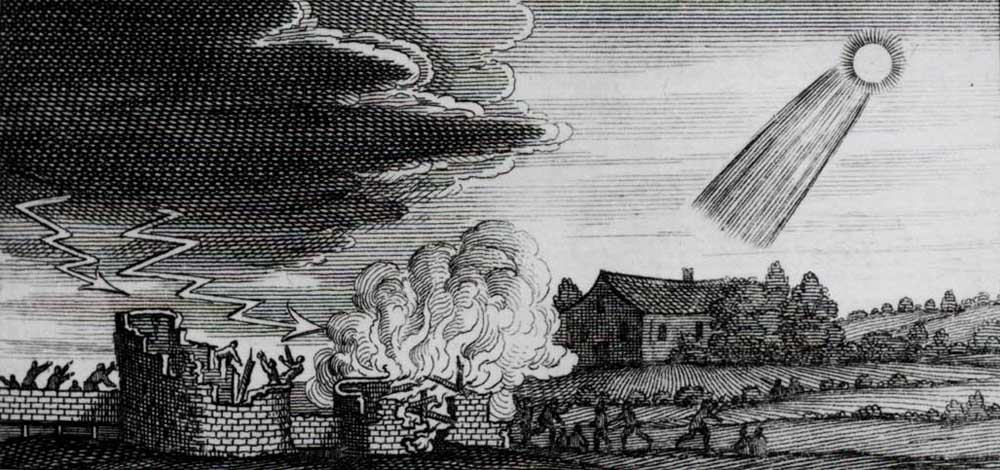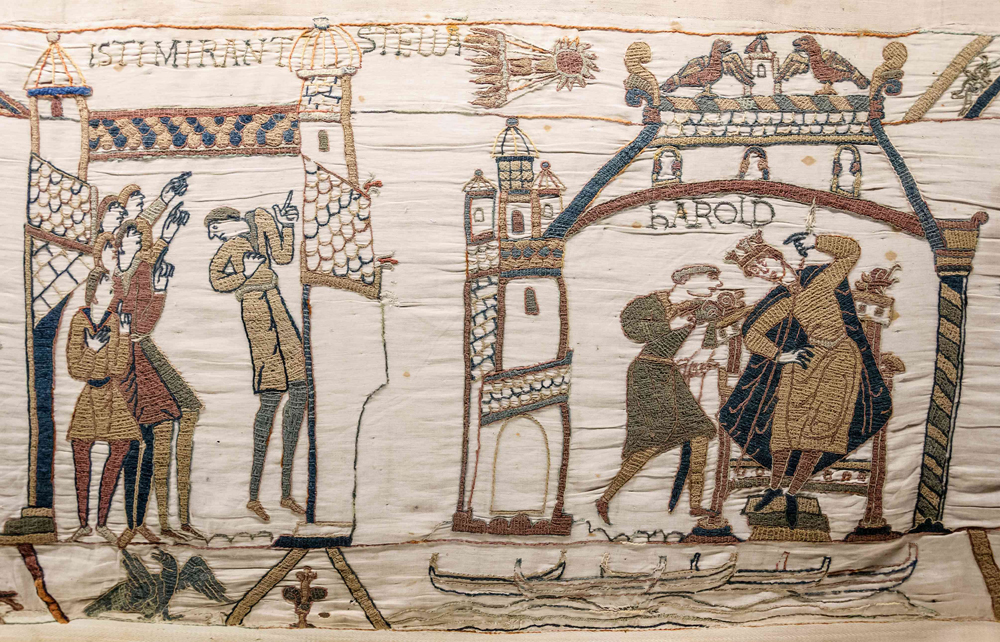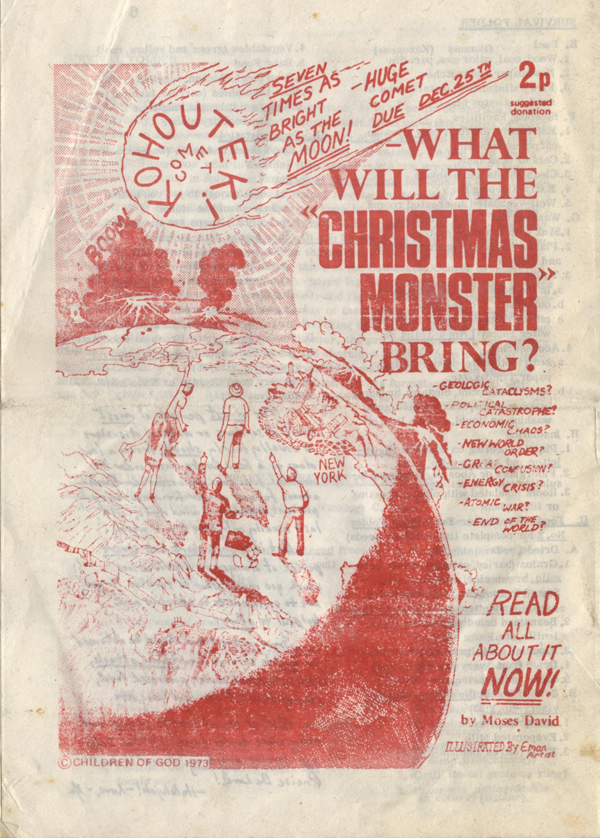

WEEK 14: MARCH 29 -- APRIL 4
TOPIC: ANCIENT IDEAS ABOUT COMETS
To our ancestors of several centuries to a few millennia ago, the nighttime sky was, to some extent anyway, a generally predictable place. The stars remained “fixed” relative to each other in the patterns that we call constellations, each culture “seeing” whatever constellations that they considered relevant. While these shifted east-to-west over the course of a night, and then over the course of a year, they always returned with predictable regularity. Meanwhile, a handful of bright “wandering stars” traveled against the pattern of the constellations, but the sky-watchers who studied these regularly found that their motions were predictable, and that they kept to a certain band of constellations that we refer to as the zodiac. These “wandering stars” are, of course, the objects we now call “planets,” and while the ancient peoples may not have understood the mechanism that produced the “wandering,” they at least found that “wandering” to be regular and predictable.
The comets, however, were a different story. These appeared at irregular intervals, without warning, and in all parts of the sky. They traveled against the background stars in paths often quite dissimilar to those of the planets, changed their appearances over the course of days or weeks – with no two comets appearing exactly alike – and would disappear as suddenly as they had appeared. Some comets, with tails stretching a considerable distance across the nighttime sky, could be truly imposing objects.
Given all this, and given the reasonable consensus that the goings-on in the nighttime sky were directly related to the goings-on here on Earth, it is easy to understand how ancient peoples came to view comets as some sort of divine or supernatural phenomenon, perhaps as some kind of messenger from whatever gods or other deities in which the particular culture involved happened to believe. Furthermore, since events like wars, natural disasters, epidemics, and so on, were always taking place, and since accordingly it would not be unusual for one or more such events to be happening around the time of a comet’s appearance, it would not be too large of a step in logic to associate the comet with those particular events. Thus, in many ancient societies comets came to be thought of as portents of disaster and/or as omens of some kind of divine displeasure.
The specific role that a comet might play in a culture’s view of the sky would depend upon the overall culture itself. The most meticulous observers of the sky one to three millennia ago were the astronomers in China and elsewhere in the Orient, who recorded the passages of numerous comets. These were generally of two types: “bushy stars” were comets that didn’t exhibit much of a tail, just a large coma; and “broom stars,” which were comets that exhibited long tails. According to some old Chinese texts, “broom stars,” in particular, would “govern the sweeping away of old things and the assimilation of the new.”
The ancient societies in Europe, beginning with the Greeks and then the Roman Empire, and then its successor societies, provide probably the best-known of the medieval views of comets. A brilliant comet appeared in 44 B.C. shortly after the assassination of Julius Caesar, and was widely believed to be his soul ascending to the heavens. (This particular comet is a future “Comet of the Week.”) The appearance of Comet 1P/Halley in A.D. 66 was believed afterwards as foretelling the destruction of Jerusalem four years later, and as discussed in this week’s “Comet of the Week” presentation, a comet that appeared in A.D. 363 (and that may have been the previous return of Comet Bennett 1969i) was believed by some to have foretold the death of the Roman emperor Jovian the following year.

 Medieval representations of comets as portents of doom. Left: A representation of the destruction wrought by a 4th Century comet. Note that the tail is directed towards the horizon, which is the opposite of the orientation comets’ tails usually exhibit. From the “Theatrum Cometicum” from Stanislaus Lubienietsky. Right: German representation of the comets of 1680, 1682 (Halley) and 1683, with three of the four “Horesemen of the Apocalypse” in the foreground, together with war instruments, religous figures, and appropriate Old Testament verses.
Medieval representations of comets as portents of doom. Left: A representation of the destruction wrought by a 4th Century comet. Note that the tail is directed towards the horizon, which is the opposite of the orientation comets’ tails usually exhibit. From the “Theatrum Cometicum” from Stanislaus Lubienietsky. Right: German representation of the comets of 1680, 1682 (Halley) and 1683, with three of the four “Horesemen of the Apocalypse” in the foreground, together with war instruments, religous figures, and appropriate Old Testament verses.
For the next millennium, as Christianity held sway throughout most of Europe, comets were almost always viewed with fear as being instruments of divine retribution against various shortcomings of humanity, and thus causing various pestilences. Pictorial representations of comets in literature of the time often embellished comets as being shaped as, or at least accompanied by, swords or other weapons of war, as well as skulls, blood, and so on. The oft-told story that the return of Comet Halley in 1456 triggered a Papal Bull requiring the people to pray for salvation from “the Devil, the Turk, and the Comet” does seem to be what we would now call an “urban legend,” however, although it’s nevertheless believable considering the tenor of the times.
Considering the overall divine/supernatural mystique that surrounded the human view of comets, there really was not much made in the way of scientific studies of them. The general prevailing view, such as it was, was put forth by the Greek philosopher Aristotle in the 4th Century B.C., and held that comets were “exhalations” of gases from the ground into the

upper atmosphere. In this way of thinking, then, comets are not celestial objects like stars or planets, but instead are phenomena of our own air. If this were true, comets could only be visible from certain locations on Earth at any given time, but since communications between widely separated locations were all but non-existent at that time there was nothing in the way of any evidence to the contrary.
This Aristotelian view of comets held sway well into the 2nd Millennium. What could probably be considered the first scientific observation of a comet was made by the German philosopher Petrus Apianus (Peter Apian), who in studying Comet Halley in 1531 noted that the comet’s tail was always directed away from the sun. (There is evidence, meanwhile, that ancient Chinese astronomers were at least somewhat aware of this fact.) Then, in 1577 the Danish astronomer Tycho Brahe carried out detailed observations of the brilliant comet that appeared that year, and was able to determine that it showed no discernible parallax when viewed from widely separated locations on Earth’s surface – thus showing that the comet was at least six times farther away from Earth than is the moon. This in turn showed conclusively that comets are true celestial objects and not phenomena of Earth’s atmosphere. (This particular comet, meanwhile, is a future “Comet of the Week.”)
Beginning with Edmond Halley’s demonstration in the early 18th Century that at least one comet returned on a regular basis and thus was a member of the solar system just like the planets, the scientific study of comets has proceeded apace, as is discussed throughout the various presentations in “Ice and Stone 2020.” While there is still plenty left to learn about these objects, they are now well within the realm of physical objects that can be examined scientifically; meanwhile, while the sight of a bright comet in the nighttime (or even daytime) sky can be breathtakingly beautiful and might well elicit feelings of a spiritual nature, they have been forever removed from the realm of the divine and supernatural.
There does remain one way in which comets can be rightfully feared: they can impact Earth, with significant and perhaps devastating effects on the biosphere, and this indeed has happened from time to time throughout Earth’s natural history. The odds that such an event might happen within our lifetimes, or even within the next several centuries, are very remote, although they are not zero. The comprehensive sky survey programs that have become operational over the past couple of decades – and that will be discussed in a future “Special Topics” presentation – should go a long way towards identifying any potentially threatening objects long before they might threaten Earth, although the long-period comets will remain an ever-present, even if very remote, threat.
Given all that we know about comets nowadays, it is unfortunate that non-scientific ideas – based somewhat on the ancients’ ideas, but intermixed with more modern “mythologies” – remain among some segments of the general public. By the time Comet Halley returned in 1910 spectroscopic studies of comets had revealed that the cyano radical CN was a constituent of comets’ comae; on a popular level this was mistakenly believed to be the poisonous gas cyanogen, and since orbital calculations suggested that Earth might be passing through the comet’s tail, this generated some public panic. I have read contemporary reports of a wealthy rancher in Albuquerque, New Mexico who committed suicide on the day of the comet’s closest approach because he did not wish to see the end of the world, and meanwhile several unscrupulous entrepreneurs made fortunes selling “comet pills” allegedly designed to ward off the effects of the “deadly gas.”

 LEFT: A 19th Century French cartoon depicting the destruction of Earth by a cometary impact. In reality, while the impact of a large comet might significantly affect the Earth's biosphere, the planet itself would remain relatively unscathed. RIGHT: A label for the “Comet Pills” sold during the 1910 return of Comet Halley.
LEFT: A 19th Century French cartoon depicting the destruction of Earth by a cometary impact. In reality, while the impact of a large comet might significantly affect the Earth's biosphere, the planet itself would remain relatively unscathed. RIGHT: A label for the “Comet Pills” sold during the 1910 return of Comet Halley.
Even more recent comets have produced fear and hysteria. Comet Kohoutek 1973f – a future “Comet of the Week” – engendered quite a bit of “end times” forecasts around the time of its appearance, even though the comet itself failed to live up to the original forecasts of its performance. I had to deal with this myself when Comet Hale-Bopp appeared, as various forms of “end times” paranoia kept rearing its head. Some of this was based on an alleged “companion” alien spacecraft supposedly accompanying the comet; there were some claims that this was “four times larger than Earth,” notwithstanding the fact that such an object would have been easily visible to the unaided eye, and even a casual glance at the comet would reveal that no such object was present. The hysteria reached its crescendo when several members of a religious cult near San Diego, California, committed mass suicide in an effort to join their “companions” aboard this “spacecraft.”

 Front and back pages of “The Christmas Monster” pamphlet distributed by a religious cult, the “Children of God,” during the appearance of Comet Kohoutek 1973f.
Front and back pages of “The Christmas Monster” pamphlet distributed by a religious cult, the “Children of God,” during the appearance of Comet Kohoutek 1973f.
Even today, the hysteria persists. Orbital calculations suggested that Comet Elenin C/2010 X1 might become a naked-eye object after its perihelion passage in September 2011, and various “end times” scenarios very quickly traveled around the Internet and in popular media. Some writers even claimed that the comet’s discoverer, Leonid Elenin, wasn’t a real person: supposedly, the “ELE” in his name stood for “Extinction Level Event,” a term that is not used scientifically but rather was coined in the 1998 movie Deep Impact, and “NIN” stood for “Nibiru Is Near,” Nibiru being a supposed planet – for which there is no scientific evidence whatsoever – that would be arriving soon and wreaking havoc. All of this was notwithstanding the facts that “Leonid” and “Elenin” are both relatively common Russian names, and that the comet’s discoverer is an accomplished amateur astronomer with four other comet discoveries to his credit. As things happened, Comet Elenin disintegrated before it reached perihelion, and even had it survived, its closest approach to Earth would only have been 0.23 AU, which is perhaps close enough to be interesting but hardly unusual or cause for concern.
 Top of the home page from the web site of the Heaven’s Gate religious cult, that committed a mass suicide near San Diego, California in March 1997 during the appearance of Comet Hale-Bopp.
Top of the home page from the web site of the Heaven’s Gate religious cult, that committed a mass suicide near San Diego, California in March 1997 during the appearance of Comet Hale-Bopp.
It would seem likely that we will see something similar when the next potentially bright comet begins to make its appearance. Indeed, if the inbound Comet ATLAS C/2019 Y4 does end up becoming a bright object – which current observations suggest is at least possible – there might well be claims that it is somehow “associated” with, say, the current coronavirus pandemic (the full extent of which is unknown at this writing). I urge all “Ice and Stone 2020” participants to ignore all this, and instead study the comet, take photographs of it, make scientific observations of it, or write stories and/or songs about it or engage in whatever other activities might be appropriate. Above all else, appreciate the beauty of the comet for its own sake. This should be the legacy of a bright comet.
“Special Topics” archive
Ice and Stone 2020 home page
Earthrise Institute home page